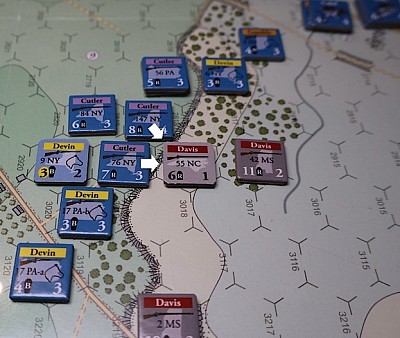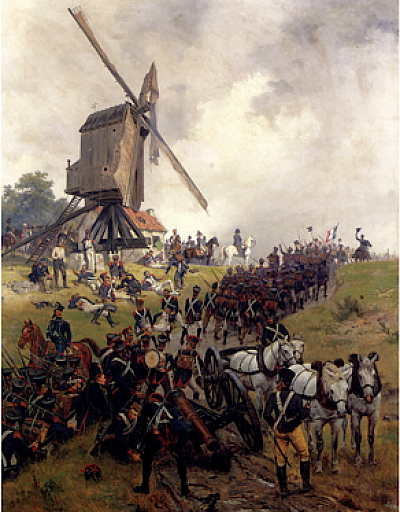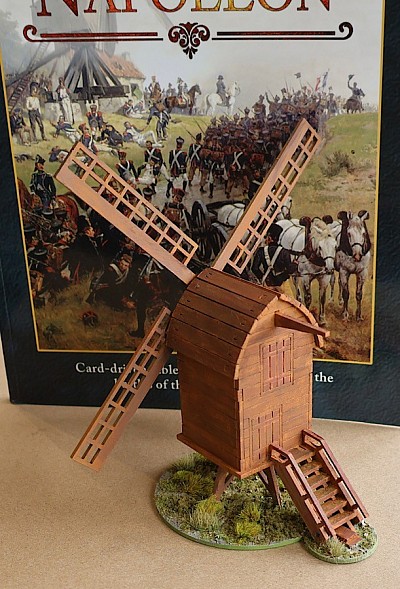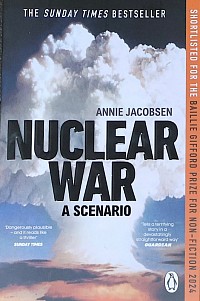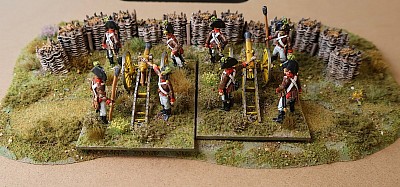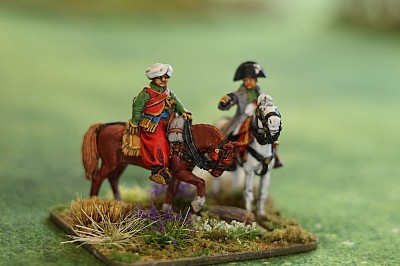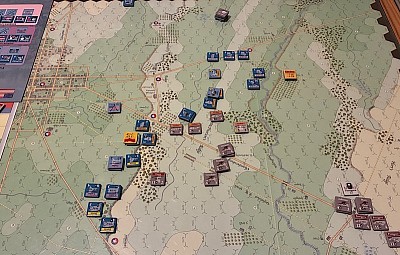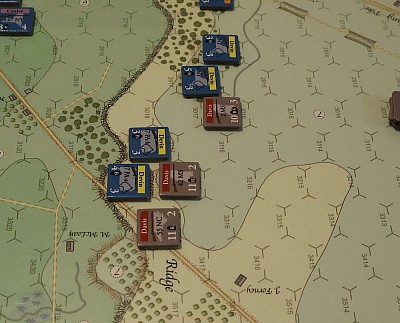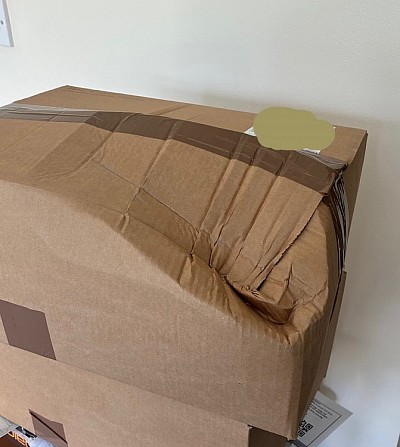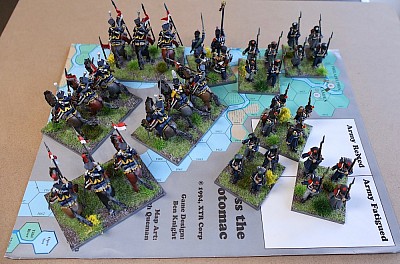Dear Diary - a rolling 4 months of comment
3rd replay of Gettysburg game
I have just enjoyed an afternoon's play of the morning scenario from the First Day at Gettysburg package.
With the rules fresh in my mind, play was slicker and a few more of the nuances of the system became obvious.
In the photo, Cutler's Brigade has just arrived and straight off the march, two of his regiments charge up the steep slope to assault the reduced 55 NC's position - will this open the line to allow Cutler to destroy that Confederate flank?
The Blind Swords system uses chit draw to activate units and Special events, to reduce a player’s unrealistic control over the game. You either like that or you don’t.
The combat system uses a two-part Combat Table and is subtly very clever. The first part takes into account all the usual combat factors and delivers a result that is directly tied to the Cohesion (training, morale etc) of the target.
If effective, you go to the second part which uses two dice. The first determines the actual damage caused to the unit in terms of casualties. The second dice (the Skedaddle dice) determines the effect on unit morale, whether it retreats, becomes shaken or becomes disrupted.
Each part of that process is looking at a different aspect of how fire / combat works. It is very well thought out.
The games do want to show off their historical credentials, though that comes with a price that the additional exclusive rules that come with each game can add to the learning curve of each new module, despite them using a common series rule set ….. but that is rewarded in the play - you do get Gettysburg.
Historically, at this point in the battle Heth fought with just two of his brigades, despite having two more in reserve. This system promotes that by making the other two brigades harder to get into action.
Recently, using a different and simpler system, I played another Gettysburg title, the rules did not put any brake at all on Heth calling up his other two brigades and that gave a game opening that essentially was ...... Not Gettysburg. Added to that, the game needed errata to cause the initial Union reinforcements to arrive in the area of McPherson's Ridge that was nearer to the historical time table.
The extra detail here certainly makes the Blind Swords game a better simulation and a more satisfactory game.
Wanting a windmill
This painting is by Ernest Crofts. It captures a moment at the Battle of Ligny (1815), when Napoleon is studying the battlefield from the high ground at Naveau, while files of French troops pass by, on their way to the battlefield.
The image adorns the box cover of ‘Ligny - Last Eagles’, a boardgame by Hexasim and of course the ‘Soldiers of Napoleon’ rules for figures that I am currently exploring.
Another mill, the Mill of Bussy on the nearby heights at Brye is mentioned in the battle accounts, again the associated high ground is used as a commanders vantage point - this time by Blücher, commanding the Prussians, while earlier in the day it had been where Blücher and Wellington met to discuss how best their armies could co-ordinate against Napoleon (Waterloo).
Windmills together with farmyards and the odd Chateaux would have been landmarks that framed the napoleonic battlefield ….. so I wanted one!
Wanting a windmill ... cont.
The Prussian battle box from the Epic range by Warlord Games has an MDF kit for a windmill, manufactured by Sarissa Productions. It is scaled to 15mm to match the Epic figures, but with its small footprint, it makes a useful item for the 28’s on a small table and has the advantage that it is compact enough to sit on a hill ….. as it well might!
Here it is, set against the background of the Soldiers of Napoleon rulebook.
It is a simple fast build kit. MDF and can be ‘interesting’ to paint because it is very absorbent, so I rattle can primed this in grey, but that seemed to need a couple of days to cure properly. After which time three coats of artists acrylic browns of various shades went down. I used a few weathering powders …… sparingly after the last time!
A quick spray of mat varnish seemed to undo all the good work that the weathering powders did.
Anyway, here we are. The 28mm figures look big against it, especially the cavalry, but I can live with the compromises as a true 28mm model would have been just too big to both store and game with.
I am debating whether to add some damaged canvas sails to it. Parchment paper might also work. Though it looks okay at the moment and I don’t want to cock it up!
Past and present dangers
Nuclear War, A Scenario by Annie Jacobsen and published by Penguin Books, is a bang-up-to-date description of how an exchange of nuclear weapons could unfold.
In some respects this is a difficult review to write because from the start of the book the reader is taken through an evolving situation and the ‘slow reveal’ is an important element of the overall telling and I would not want anything written here to diminish that in any way.
Of note is that Jacobsen has thoroughly researched the subject and that includes having conversations and interviews with people who are well placed to comment.
I did initially feel that she was writing from an overtly anti-nuclear weapon perspective, giving a worst-case picture and I wondered about objectiveness, but as I read on, it became very clear that with facts at hand, such a perspective becomes increasingly understandable and vindicated. Just learning about how many warheads actually exist is of itself a shocking revelation, particularly as individually their destructive power is of an order of magnitude greater than the original atom bombs.
Pages 304 to 360 are a succession of source notes. Jacobsen is making sure that we can see and appreciate the footwork that has gone into her construction.
As the reader advances through the book, the facts of hardware, capability and process are well laid out. For some of us of a certain age, it brings to the fore a memory of some of the nuclear-related things that we were told back in the late 70's, when the world seemed a dangerous place, with Europe’s menacing Iron Curtain and large armies deployed on either side of it, setting the mood of nations.
Despite much of the protocol ‘process’ being government related, Jacobsen does not bang a political drum, she doesn’t need to, the reader, well aware of the current world tensions will fill in the gaps themselves as to how the contents of her book relate to the question of whether the suspicion and lack of co-operation between world leaders today could feed into her scenario.
To give a basic outline of the book, we are helped by the book being divided into clear sections. The first section describes the period between the first nuclear detonation to where we are today in terms of nuclear armament, the number of weapons and who controls them. It is an interesting history and summary.
Next, seemingly almost too easily, someone presses the button and a nuclear weapon is launched. In this scenario we are told exactly where the missile originates because within seconds a satellite has picked up the ignition signature of the rocket. There isn’t a preamble to this, a back story or an evolving of deteriorating situation, we are simply told that a missile has been launched, which then allows everything that follows to hang off this and for the author’s research to come to life.
The next section of the book is called ‘The First 24 Minutes’ and sets the tone for what will follow. In micro chapters we get a breakdown of the various processes and protocols that will cover this section of time. ‘7 Minutes - U.S. Army Space and Missile Defence Command, Fort Greely, Alaska’ “To discern a nuclear warhead from a decoy is the job of the one-of-a-kind SBX radar system at sea” and so we are advised of detection, decisions and counter-measures.
The section concludes with the just launched Intercontinental Ballistic Missile (ICBM) reaching its target. The question during flight is whether it is a decoy or real? Should there be retaliation? Now the reader knows!
The following section continues with process and decisions, but now feeds consequences into the mix. It is called ‘The next 24 minutes’, but I shall say no more to save spoiling things for the reader.
We progress to ‘The Next (and final) 24 Minutes. Not a great deal of time has passed since the scenario opened, but already world-changing events are set in irreversible motion.
The final part of the book covers ‘The Next 24 Months and Beyond (Or, Where We Are Headed after a Nuclear Exchange).
By the last page Annie Jacobsen has left the reader much better informed of how the first couple of minutes of nuclear war would play out and of the systems and protocols involved that have evolved since 1945 shape that.
Her account makes the consequences of nuclear exchange very real. It is both fascinating and unnerving.
I am reminded of a book that I first read in 1980 - ‘World War III’ forwarded by Sir General John Hackett and the follow-up book ‘The Untold Story’, which together described how alarmingly easy it was to slip into escalation of global conflict. I can’t recall a publication between then and now that encapsulates so well a military-based ‘present danger’.
In 2024, Nuclear War, A Scenario was shortlisted for the Baillie Gifford Prize for non-fiction.
Gabion defences
This is the latest terrain piece to roll off the painting tray. It combines the superb resin Gabion Defence sold by Ironclad Miniatures with a base formed from an old table mat.
With a jigsaw set at 45˚ to give a chamfered edge, an irregular shape was cut from a good stout table mat. Keeping the laminate surface face down and gluing the gabion section directly onto the mat’s cork base and then applying various filler pastes, I seem to have got away with any warping. A couple of pieces of grass mat were also added.
Overall, a very useful defensive position that helpfully has a small footprint of 10" wide by 6" deep. The pair of guns have a combined frontage of 120mm (just under 5").
Trial game - Soldiers of Napoleon
I had a very pleasant afternoon today with the 28mm Napoleonics giving the Soldiers of Napoleon a run through on the table.
A full description of my initial observations are now up over on the Battlefields and Warrior Blog at the below link.
The photo here is my rather nice French command stand featuring Ali the Mameluke and Napoleon - sculpts from the Perry's.
Link
https://battlefieldswarriors.blogspot.com/2025/10/a-dipping-toe-soldiers-of-napoleon.html
Face-to-Face Gettysbury
The photo on the right shows the high watermark of the Confederate advance during the morning of day one of the Gettysburg battle. Union reinforcements have arrived and they are pressing the Confederates, who are compelled to pull back.
By the scenario end, they still manage to hold on to the 'Union side' of Willoughby Run, with their guns behind them, back up on Herr Ridge. It ends as a Union victory.
As a broad view we both felt that we really liked what transpired on table, but that it felt too complicated for its own good. This is a fairly meaty system which stretch our normal gaming sessions, so for most of the time, we would find ourselves needing to record the game and then setting up again a couple of weeks later.
But its depths are a pleasure compaired to the generic nature of some designs. I recently played another Gettysburg design and that had an immediate problem that Heth was able to get all of his four brigades into action all too quickly, which always skewed what would follow. Here, there are the historical restraints on getting his supporting two brigades into action and it makes the history feel so much better.
In fact the whole package is very true to the history and the designer has clearly taken a lot of care to get everything right and everything just oozes with that care.
I don't think you could stay away from this system for long without needing a bit of effort to pick it back up. The exclusive rules are quite long, plus there are individual scenario rules and I wonder whether this is just too much goodness.
At this particular moment I find myself wanting to love this game more than my practical circumstances allow ..... but I also think that this might be an unfair moment to judge as I am still going through the learning curve and I wonder whether with more regular play, a lot of this would just automatically click.
It might be interesting to play another game in the system (which I have) and just see whether via the exclusive rules there are just too many differences mixed with loads of similarities that make moving between each game harder than I am looking for - so there is more to explore here.
I don't think Mike is sold on it and that matters as we want our face-to-face games to be giving maximum enjoyment. More to think about on this one.
First 'hours' at Gettysburg.
Having read the rules through once, I thought it best just to put a short scenario out to try and embed the rules and game process into memory.
A couple of turns in and Davis, who forms the Confederate left wing, has advanced onto McPherson's Ridge to get amongst Devlin’s dismounted cavalrymen.
The dynamic of this part of the battle was the question of how long the Union cavalry could hold out while Cutler’s and Meredith’s brigades were racing up to support them, and that tension translates into the game.
You can see the Confederate units here in grey having good strength (left value), but not so hot cohesion (right value), so they have good hitting power, but can be a bit shaky when taking fire / close combat.
There is a lot going on in the game, with the chit pull to activate brigades and introduce events, bringing some local chaos. I liked a moment when I drew the Sharpshooters chit from the draw bag for the Confederates. This gave them an attack opportunity at any Union unit at up to a range of 3 hexes from a chosen Confederate unit. They targeted a Union unit that was positioned to become involved in a joint attack against one of Davis’ regiments. The Union unit was forced to retreat 2 hexes from the sharpshooter fire. The lone Union unit remaining went on to attack alone and was ruthlessly rebuffed - in a moment, a crisis had been averted and some lovely game narrative had been created.
Just as Davis became significantly entangled with Devlin, Cutler arrived on scene and immediately off the march attacked Davis. On the face of it, it looked like Davis was outpositioned and outnumbered… but as the Union (Cutler) put their attack in, Davis got a couple of spectacular ‘Defensive Fires’ in, which really broke up the Union attack. This sort of unpredictability is hugely helpful in solo play.
However, Meredith (The Iron Brigade - Union) is now also approaching and a Union counter-attack can soon begin in earnest. The Confederates are having ongoing problems bringing their other two brigades up for support, so if I were a betting man looking at the game now, I can see the Union pushing the Confederates back over Willoughby Run before the scenario ends and probably coming out with a win for themselves.
It is time to return to the rule book for another sweep!
Wow - Thank You Royal Mail!
This arrived yesterday ..... a baddly biffed box containing painted Duchy of Warsaw lancers!
I know from my previous painting of one of these units, just how fragile the lances are and it was with some trepidation that I opened the box!
However, considering the amount of damage, I was really lucky. The seller had packed the figures really well and then suspended them in the centre of the box by adding paper packing all the way around the bubble of figures, sort of suspending them - thank you.
I recently bought a rather nice boardgame that when it arrived, the carton had a crushed corner on the box resulting in a 'ding' on the boardgame box inside. Considering I keep these things pristine, that was a real spoiler.
Come on Royal Mail - you can do better than this!
Some joy through the post!
The last of the e-Bay pot just got spent on two figure listings and rather nice they are too.
The first is a unit of French Light Infantry. 24 figures on six 40mm x 40mm bases. I will re-base these onto two lots of 80mm bases using 20 of those figures.
The cavalry are Polish Lancers and are just lovely - a pleasure to own. I really wasn't sure about bidding on these as my main area of interest didn't appear to see them deployed as French Allies.
They were formed in 1807 so miss the Austerlitz 1805 battles and were very much in use during the Russia 1812 campaign, which I am not presently covering.
Anyway, a bit of research showed that they did fight independently of the French in 1809 against the Austrians, defending their country from Austrian attack.
As I already have a Duchy of Warsaw infantry unit and the 14th Cuirassiers, I have the basis to show a Polish force and I am quite happy to proxy French units for the rest, so there you are, the bid went in and I'm so pleased to have them.
I think I will buy another box of Duchy of Warsaw Infantry and make up a second unit.
Above
A small slice of the First Day at Gettysburg map. Nice and clear graphics. I am just halfway through the series rulebook ....... but I have nodded off twice while reading - Oh Dear!
This opening to the battle is, for some reason, one of the most interesting parts of the campaign for me. At this tactical level, there are more cavalry counters than I have seen before when gaming the situation, so it will be interesting to see how they function in this system.
The cavalry seem to start much further back from Willoughby Run than I have them when playing with figures. The scenario starts at 9 AM and one of Archer's Brigades already has losses, so I suspect if I check my sources, the initial earlier attack has already happened and the cavalry have fallen back accordingly. Looking forward to this.
Prussian Farmyard
The starting point to this was that for some time, I had wanted a ‘farmyard’ type complex for my Napoleonic table - something that looked like a continental farmyard with a high wall.
There is a nostalgic aspect to this going back to my young teenage years. I had the Airfix Napoleonic farmyard, together with all the French and British Airfix soldiers that a boy could want ... and all painted - badly, but still painted.
My mother got talking to the next door neighbour. They had a nephew who did this strange wargame thing and they arranged for him to call around. I set up the farmhouse together with rank upon rank of soldiers …… he brought some metal figures, including a horse and limber.
I was mesmerised with the metals and a passion for properly painted ‘grown up’ figures was born that instant. I would have swapped everything I owned for those few metals! Anyway, that meeting, the game and the farmhouse at the centre of the action is one of those memorable hobby moments …. I am early mid teens, standing in our old front room, with the dining table set up in the middle and I am Wellington!
So of course, it is of no surprise that when browsing the Warbases webpage for Napoleonic ammunition carts, when I strayed to the buildings section and found their ‘Prussian Farmyard’ MDF kit for the princely sum of £27, it was an automatic purchase, a period walled farmhouse with a very helpful footprint of just 8½" x 11".
It is a relatively fast and easy build, thankfully as mine did not have instructions ….. and the reason why a capping stone from the wall has ended up in the base of a chimney!
One of the three buildings comes with card coverings to give the MDF barn a wooden structure look and that works very well, but the other two buildings and walls are plain MDF and need some help.
For these two buildings I made individual roof tiles from thin card, laborious, but worth it.
For the whole complex, I was quite happy with the whitewash look that seems common of the period, so I covered all of the walls with a mixture of white Gesso, modellers paste and a touch of Vallejo something or other that has a bit of fine sand in it. I used a ½" flat head brush to get the first coat on and then once dry applied an artist's acrylic linen colour with a very slight tint of raw sienna.
A very thin coating of the same went onto the courtyard ground for the sandy texture, with various browns then scrubbed in.
I had intended to do the roof in a red tile, just like the photograph that Airfix used on the front of their kit box, but after some internet checking, the further that we move towards Prussia / Austria, it seems that these buildings tended towards grey slate roofing, so I have gone with that.
Completed with some flocks and rattle can matt varnish, the final result is a terrain piece that will come out often, it will hold a battalion of infantry, scales well with the figures and has a compact base size.
A Bridge Too Far!
Last night our face-to-face game took the recent release 'Market-Garden' published by Compass Games for a spin. This is Volume II in their WWII Commander series.
This is an Area Movement game (rather than hexes). The map and playing pieces are nicely done and the system is very playable, so no need for the rulebook to get in the way of tactical plans and just playing the game.
Having said that, some mistakes crept in. We missed an important point on the Out of Supply rules, which mattered at Arnhem and we both had one incident of forgetting to bring on reinforcements, which delayed them a turn and again one of those incidents mattered for the Allies at Arnhem when the Polish Airborne and their supply were due to arrive to hopefully save the day.
I would have liked to have seen a timetable printed on the board to show how well the British 30th Corps advance was doing compared to the historical positions. The Allies were against the clock and a timetable would help to deliver that sense of pressure and would also help the German player measure how well they are doing.
Like Gettysburg and Waterloo etc, there have been plenty of Arnhem game designs, but overall, in terms of the type of game that I like, this is one is up there as a good game.
The downside for me was that despite moving the turns along at a good pace, the game still didn't fit into our typical 3 hour gaming session. By close of play, we were still a few turns away from when the game should end.
The Allies had reached Nijmegen and Arnhem was contested and so the disappointing conversation was had, trying to second guess what the completed game outcome would likely have been had we reached the end.
This evaluation was made all the harder by getting rules wrong that concerned Arnhem itself, so we could not be sure whether Arnhem would actually have still been Allied controlled at the point that we ended play, making the second guessing rather pointless.
